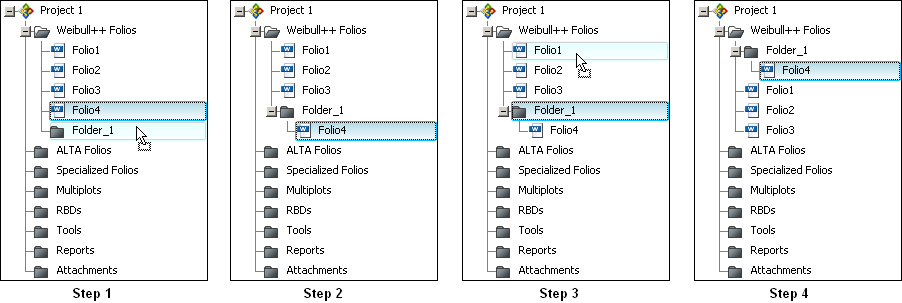![]()
![]()
| Related Topics: | ||
Once you have opened a project, you can use the current project explorer to manage the items (e.g., folios and multiplots in Weibull++ and ALTA, block diagrams and analyses in BlockSim, system hierarchy items in Xfmea/RCM++, and the like) within the current project. The current project explorer presents all the current items in a hierarchical tree structure. The project name (e.g., Project1) is displayed at the top of the tree structure. The folders that contain the analysis and reporting components of the current project as well as project-level attachments are displayed below the project name. Click the plus (+) button to open a folder and display the items within that folder. Click the minus (-) button to close a folder. Double-click an item to open that item in the MDI or to bring that item to the front of the MDI if it is already open. If you double-click an attachment that appears in the current project explorer, it will open in its corresponding application, as long as that application is installed on your computer.
Note: In Synthesis-enabled applications, projects can be shared by multiple users and the current project explorer may display an "in-use" icon to indicate the status of an item that can't be edited because it is currently locked or being edited by another user. See Simultaneous Access By Multiple Users.
You can add items to the project by choosing the relevant command on the Insert tab of the Ribbon. You can also right-click the relevant folder in the current project explorer and choose the Add command on the shortcut menu that appears. To manage existing items within the project, select the analysis, report or attachment and use the commands in the Current Item group on the Project tab of the Ribbon (i.e., Edit Item, Rename Item, Duplicate Item and Delete Item) or on the shortcut menu that appears when you right-click the item.
You can create additional levels of folders within the folder for each type of project item by right-clicking the folder and choosing Add Folder on the shortcut menu. Add as many folders, in as many levels, as you need to keep your work organized.
Arrange folders and project items by dragging them to the desired location. Dragging an item (folder or project item) onto a folder will place the dragged item into the folder. Dragging an item onto a project item will place the dragged item above the target project item. For example, consider the following steps:

In Step 1, Folio4 is being dragged onto Folder_1. Step 2 shows that Folio4 is then located within Folder_1. In Step 3, Folder_1 is being dragged onto Folio1. Step 4 shows that Folder_1 is then positioned above Folio1. To move an item to the bottom of the list, drag it onto the category folder (e.g., in this case, you could drag Folder_1 onto the Weibull++ Folios folder to return it to its original location at the end of the group).
Note: The current project explorer shows the project content that is applicable for the current application; however, all Synthesis-enabled applications will be able to access the project's resources and attachments.
You can use the Filter based on creator drop-down list to filter the items that are currently displayed in the current project explorer by the name of the user who created them. The available names are based on the user accounts defined in the current database.
What's Changed? In version 7, if you had both Weibull++ and ALTA installed, you could switch between the applications using Application buttons at the bottom of the Project Explorer. In Version 8, both applications have been integrated into a single user interface and are integrated with other applications via the Synthesis Platform. See Introduction.
© 1992-2013. ReliaSoft Corporation. ALL RIGHTS RESERVED.